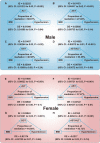Liver indicators affecting the relationship between BMI and hypertension in type 2 diabetes: a mediation analysis
- PMID: 38229128
- PMCID: PMC10792781
- DOI: 10.1186/s13098-023-01254-z
Liver indicators affecting the relationship between BMI and hypertension in type 2 diabetes: a mediation analysis
Abstract
Background: Body mass index (BMI) is an important risk factor for hypertension in diabetic patients. However, the underlying mechanisms remain poorly understood. Although liver-derived biological intermediates may play irreplaceable roles in the pathophysiology of diabetes, few studies have explored them in the association between BMI and hypertension in diabetes.
Objective: To investigate the role of liver enzymes in mediating the relationship between BIM exposure and hypertension in type 2 diabetes mellitus (T2DM).
Methods: We included a total of 1765 participants from the China National Diabetic Chronic Complications Study Cohort. Associations between liver enzymes and hypertension were estimated using multivariable regression models. The function of liver indicators in the relationship between BMI and hypertension was assessed using mediation analysis. Mediation analysis was conducted, taking into account age, diabetes duration, current smoking, fasting plasma glucose level, glycated hemoglobin, anti-diabetic therapy, and family history of diseases, including diabetes, hypertension, obesity, and hyperlipidemia.
Results: For men, the association of BMI with hypertension was partially mediated by alanine aminotransferase (ALT), with a proportion of mediation was 68.67%, by aspartate aminotransferase (AST) was 27.02%, and by γ-glutamyltransferase (GGT) was 38.58%, by AST/ALT was 63.35%; for women, the proportion mediated by ALT was 36.93%, and by AST was 37.47%, and GGT was 44.60%, and AST/ALT was 43.73% for BMI (all P < 0.05).
Conclusion: The effect of BMI on hypertension is partly mediated by liver indicators (ALT, AST, GGT, and AST/ALT) in diabetic patients. Our results may provide opportunities to identify new targets for hypertension interventions.
Keywords: BMI; Hypertension; Liver indicators; Mediation effect; Type 2 diabetes mellitus.
© 2024. The Author(s).
Conflict of interest statement
The authors declare no competing interests.
Figures


Similar articles
-
Liver enzymes as mediators of association between obesity and diabetes: the Guangzhou Biobank Cohort Study.Ann Epidemiol. 2017 Mar;27(3):204-207. doi: 10.1016/j.annepidem.2016.11.002. Epub 2016 Nov 20. Ann Epidemiol. 2017. PMID: 27923538
-
Role of Liver Enzymes in the Relationship Between Particulate Matter Exposure and Diabetes Risk: A Longitudinal Cohort Study.J Clin Endocrinol Metab. 2022 Sep 28;107(10):e4086-e4097. doi: 10.1210/clinem/dgac438. J Clin Endocrinol Metab. 2022. PMID: 35861878
-
Increased liver markers are associated with higher risk of type 2 diabetes.World J Gastroenterol. 2015 Jun 28;21(24):7478-87. doi: 10.3748/wjg.v21.i24.7478. World J Gastroenterol. 2015. PMID: 26139993 Free PMC article.
-
Prevalence of abnormal serum liver enzymes in patients with type 2 diabetes mellitus: a cross-sectional study from China.Postgrad Med. 2016 Nov;128(8):770-776. doi: 10.1080/00325481.2016.1242366. Epub 2016 Oct 17. Postgrad Med. 2016. PMID: 27681272
-
AST to ALT ratio and arterial stiffness in non-fatty liver Japanese population:a secondary analysis based on a cross-sectional study.Lipids Health Dis. 2018 Dec 3;17(1):275. doi: 10.1186/s12944-018-0920-4. Lipids Health Dis. 2018. PMID: 30509277 Free PMC article. Review.
Cited by
-
The mediation effect of liver and anthropometric indices on the relationship between incidence of diabetes and physical activity: results of 5-year follow up azar cohort study.BMC Public Health. 2024 Nov 18;24(1):3190. doi: 10.1186/s12889-024-20587-6. BMC Public Health. 2024. PMID: 39558270 Free PMC article.
-
The potential of spironolactone to mitigate the risk of nonalcoholic fatty liver disease in hypertensive populations: evidence from a cohort study.Eur J Gastroenterol Hepatol. 2025 Sep 1;37(9):1010-1020. doi: 10.1097/MEG.0000000000002986. Epub 2025 Apr 29. Eur J Gastroenterol Hepatol. 2025. PMID: 40359267 Free PMC article.
References
Grants and funding
LinkOut - more resources
Full Text Sources
Miscellaneous

